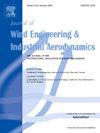基于双输出lstm回归与分类模型的短期极端风速预报
IF 4.2
2区 工程技术
Q1 ENGINEERING, CIVIL
Journal of Wind Engineering and Industrial Aerodynamics
Pub Date : 2025-02-13
DOI:10.1016/j.jweia.2025.106035
引用次数: 0
摘要
本研究介绍了一种结合回归和分类技术的双输出长短期记忆和变压器(LSTM-Transformer)模型预测极端风速(EWS)的方法。该过程包括三个阶段:使用极值分析(EVA)建立极端事件阈值,使用历史天气数据训练模型以进行精确的点预测和分类,以及校准输出以准确识别极端事件。该模型使用与每个输出相对应的损失的组合进行训练,并调整权重。利用来自洛杉矶、芝加哥和休斯顿的60分钟和90分钟预报间隔的数据进行评估,该模型在特定气候条件下表现合理,在准确性和泛化性方面优于其单输出回归和分类对应。这表明了在特定地区实际应用的巨大潜力。至关重要的是,该研究揭示了模型的预测性能与不平衡比密切相关,突出了模型性能与数据集中风速分布之间的重要联系。这就突出了在预测模型中考虑失衡比的重要性,特别是在根据典型工程实践整合EVA时。这种创新的方法为加强EWS预测提供了一个可靠和灵活的框架,为管理基础设施的安全和决策过程做出了重大贡献。本文章由计算机程序翻译,如有差异,请以英文原文为准。
Short-term extreme wind speed forecasting using dual-output LSTM-based regression and classification model
This study introduces a methodology for forecasting extreme wind speeds (EWS) using a dual-output long short-term memory and transformer (LSTM-Transformer) model that combines regression and classification techniques. The process involves three stages: establishing extreme event thresholds using extreme value analysis (EVA), training the model on historical weather data for precise point forecasting and classification, and calibrating the output for accurate extreme event identification. The model is trained using a combination of the losses corresponding to each output with tuned weights. Evaluated using data from Los Angeles, Chicago, and Houston, for a 60 and 90 min forecast interval, the model demonstrates reasonable performance in specific climatic conditions, outperforming its single-output regression and classification counterparts in terms of both accuracy and generalisation. This indicates strong potential for real-world applications in specific regions. Crucially, the study reveals that the forecast performances of the model are closely related to the imbalance ratios, highlighting a significant link between the model’s performance and the distribution of wind speed within the dataset. This highlights the importance of considering the imbalance ratio in the predictive model, especially when integrating EVA according to typical engineering practices. This innovative approach offers a reliable and flexible framework for enhancing EWS predictions, contributing significantly to the safety and decision-making processes in managing infrastructures.
求助全文
通过发布文献求助,成功后即可免费获取论文全文。
去求助
来源期刊
CiteScore
8.90
自引率
22.90%
发文量
306
审稿时长
4.4 months
期刊介绍:
The objective of the journal is to provide a means for the publication and interchange of information, on an international basis, on all those aspects of wind engineering that are included in the activities of the International Association for Wind Engineering http://www.iawe.org/. These are: social and economic impact of wind effects; wind characteristics and structure, local wind environments, wind loads and structural response, diffusion, pollutant dispersion and matter transport, wind effects on building heat loss and ventilation, wind effects on transport systems, aerodynamic aspects of wind energy generation, and codification of wind effects.
Papers on these subjects describing full-scale measurements, wind-tunnel simulation studies, computational or theoretical methods are published, as well as papers dealing with the development of techniques and apparatus for wind engineering experiments.

 求助内容:
求助内容: 应助结果提醒方式:
应助结果提醒方式:


